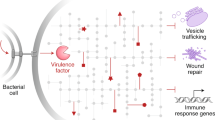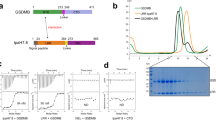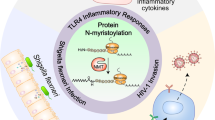Abstract
Protein N-myristoylation is a 14-carbon fatty-acid modification that is conserved across eukaryotic species and occurs on nearly 1% of the cellular proteome1,2. The ability of the myristoyl group to facilitate dynamic protein–protein and protein–membrane interactions (known as the myristoyl switch) makes it an essential feature of many signal transduction systems3. Thus pathogenic strategies that facilitate protein demyristoylation would markedly alter the signalling landscape of infected host cells. Here we describe an irreversible mechanism of protein demyristoylation catalysed by invasion plasmid antigen J (IpaJ), a previously uncharacterized Shigella flexneri type III effector protein with cysteine protease activity. A yeast genetic screen for IpaJ substrates identified ADP-ribosylation factor (ARF)1p and ARF2p, small molecular mass GTPases that regulate cargo transport through the Golgi apparatus4. Mass spectrometry showed that IpaJ cleaved the peptide bond between N-myristoylated glycine-2 and asparagine-3 of human ARF1, thereby providing a new mechanism for host secretory inhibition by a bacterial pathogen5,6. We further demonstrate that IpaJ cleaves an array of N-myristoylated proteins involved in cellular growth, signal transduction, autophagasome maturation and organelle function. Taken together, these findings show a previously unrecognized pathogenic mechanism for the site-specific elimination of N-myristoyl protein modification.
This is a preview of subscription content, access via your institution
Access options
Subscribe to this journal
Receive 51 print issues and online access
$199.00 per year
only $3.90 per issue
Buy this article
- Purchase on SpringerLink
- Instant access to full article PDF
Prices may be subject to local taxes which are calculated during checkout




Similar content being viewed by others
References
Farazi, T. A., Waksman, G. & Gordon, J. I. The biology and enzymology of protein N-myristoylation. J. Biol. Chem. 276, 39501–39504 (2001)
Maurer-Stroh, S. et al. MYRbase: analysis of genome-wide glycine myristoylation enlarges the functional spectrum of eukaryotic myristoylated proteins. Genome Biol. 5, R21 (2004)
McLaughlin, S. & Aderem, A. The myristoyl-electrostatic switch: a modulator of reversible protein-membrane interactions. Trends Biochem. Sci. 20, 272–276 (1995)
Kahn, R. A. Toward a model for Arf GTPases as regulators of traffic at the Golgi. FEBS Lett. 583, 3872–3879 (2009)
Dong, N. et al. Structurally distinct bacterial TBC-like GAPs link Arf GTPase to Rab1 inactivation to counteract host defenses. Cell 150, 1029–1041 (2012)
Mounier, J. et al. Shigella effector IpaB-induced cholesterol relocation disrupts the Golgi complex and recycling network to inhibit host cell secretion. Cell Host Microbe 12, 381–389 (2012)
Selyunin, A. S. et al. The assembly of a GTPase-kinase signalling complex by a bacterial catalytic scaffold. Nature 469, 107–111 (2011)
Ashida, H. et al. Shigella are versatile mucosal pathogens that circumvent the host innate immune system. Curr. Opin. Immunol. 23, 448–455 (2011)
Way, S. S., Borczuk, A. C., Dominitz, R. & Goldberg, M. B. An essential role for gamma interferon in innate resistance to Shigella flexneri infection. Infect. Immun. 66, 1342–1348 (1998)
Buysse, J. M., Dunyak, D. S., Hartman, A. B. & Venkatesan, M. M. Identification and molecular characterization of a 27 kDa Shigella flexneri invasion plasmid antigen, IpaJ. Microb. Pathog. 23, 357–369 (1997)
Liu, M. et al. Sequence analysis and characterization of plasmid pSFD10 from Salmonella choleraesuis. Plasmid 48, 59–63 (2002)
Michiels, J., Dirix, G., Vanderleyden, J. & Xi, C. Processing and export of peptide pheromones and bacteriocins in Gram-negative bacteria. Trends Microbiol. 9, 164–168 (2001)
Slagowski, N. L., Kramer, R. W., Morrison, M. F., LaBaer, J. & Lesser, C. F. A functional genomic yeast screen to identify pathogenic bacterial proteins. PLoS Pathog. 4, e9 (2008)
Herman, P. K., Stack, J. H., DeModena, J. A. & Emr, S. D. A novel protein kinase homolog essential for protein sorting to the yeast lysosome-like vacuole. Cell 64, 425–437 (1991)
Sze, S. K., Ge, Y., Oh, H. & McLafferty, F. W. Top-down mass spectrometry of a 29-kDa protein for characterization of any posttranslational modification to within one residue. Proc. Natl Acad. Sci. USA 99, 1774–1779 (2002)
Kelleher, N. L. Top-down proteomics. Anal. Chem. 76, 197A–203A (2004)
Charron, G. et al. Robust fluorescent detection of protein fatty-acylation with chemical reporters. J. Am. Chem. Soc. 131, 4967–4975 (2009)
Barr, F. A., Puype, M., Vandekerckhove, J. & Warren, G. GRASP65, a protein involved in the stacking of Golgi cisternae. Cell 91, 253–262 (1997)
Kamps, M. P., Buss, J. E. & Sefton, B. M. Mutation of NH2-terminal glycine of p60src prevents both myristoylation and morphological transformation. Proc. Natl Acad. Sci. USA 82, 4625–4628 (1985)
Stumpo, D. J., Graff, J. M., Albert, K. A., Greengard, P. & Blackshear, P. J. Molecular cloning, characterization, and expression of a cDNA encoding the “80- to 87-kDa” myristoylated alanine-rich C kinase substrate: a major cellular substrate for protein kinase C. Proc. Natl Acad. Sci. USA 86, 4012–4016 (1989)
Sun, Q. et al. Identification of Barkor as a mammalian autophagy-specific factor for Beclin 1 and class III phosphatidylinositol 3-kinase. Proc. Natl Acad. Sci. USA 105, 19211–19216 (2008)
Franco, M., Chardin, P., Chabre, M. & Paris, S. Myristoylation-facilitated binding of the G protein ARF1GDP to membrane phospholipids is required for its activation by a soluble nucleotide exchange factor. J. Biol. Chem. 271, 1573–1578 (1996)
Liu, Y., Kahn, R. A. & Prestegard, J. H. Structure and membrane interaction of myristoylated ARF1. Structure 17, 79–87 (2009)
Liu, Y., Kahn, R. A. & Prestegard, J. H. Dynamic structure of membrane-anchored Arf*GTP. Nature Struct. Mol. Biol. 17, 876–881 (2010)
Shao, F., Merritt, P. M., Bao, Z., Innes, R. W. & Dixon, J. E. A Yersinia effector and a Pseudomonas avirulence protein define a family of cysteine proteases functioning in bacterial pathogenesis. Cell 109, 575–588 (2002)
Choy, A. et al. The Legionella effector RavZ inhibits host autophagy through irreversible Atg8 deconjugation. Science 338, 1072–1076 (2012)
Phalipon, A. & Sansonetti, P. J. Shigellosis: innate mechanisms of inflammatory destruction of the intestinal epithelium, adaptive immune response, and vaccine development. Crit. Rev. Immunol. 23, 371–401 (2003)
Datsenko, K. A. & Wanner, B. L. One-step inactivation of chromosomal genes in Escherichia coli K-12 using PCR products. Proc. Natl Acad. Sci. USA 97, 6640–6645 (2000)
Pei, J., Kim, B. H. & Grishin, N. V. PROMALS3D: a tool for multiple protein sequence and structure alignments. Nucleic Acids Res. 36, 2295–2300 (2008)
Roth, M. J. et al. Sensitive and reproducible intact mass analysis of complex protein mixtures with superficially porous capillary reversed-phase liquid chromatography mass spectrometry. Anal. Chem. 83, 9586–9592 (2011)
Shima, D. T., Haldar, K., Pepperkok, R., Watson, R. & Warren, G. Partitioning of the Golgi apparatus during mitosis in living HeLa cells. J. Cell Biol. 137, 1211–1228 (1997)
Steele-Mortimer, O. Meresse, S. Gorvel, J. P., Toh, B. H. & Finlay, B. B. Biogenesis of Salmonella typhimurium-containing vacuoles in epithelial cells involves interactions with the early endocytic pathway. Cell. Microbiol. 1, 33–49 (1999)
Shiloh, M. U. et al. Phenotype of mice and macrophages deficient in both phagocyte oxidase and inducible nitric oxide synthase. Immunity 10, 29–38 (1999)
Rivera, V. M. et al. Regulation of protein secretion through controlled aggregation in the endoplasmic reticulum. Science 287, 826–830 (2000)
Soding, J., Biegert, A. & Lupas, A. N. The HHpred interactive server for protein homology detection and structure prediction. Nucleic Acids Res. 33, W244–W248 (2005)
Alto, N. M. & Dixon, J. E. Analysis of Rho-GTPase mimicry by a family of bacterial type III effector proteins. Methods Enzymol. 439, 131–143 (2008)
Acknowledgements
We thank our colleagues at University of Texas Southwestern Medical Center, specifically K. Orth, Y. M. Chook and J. Seeman, for discussions in preparing this manuscript. We are particularly indebted to L. Kinch, N. Grishin, D. Mitchel, X. Guo, D. Trudgian and S. Perelman for their contributions. We acknowledge the services of the University of Texas Southwestern Medical Center proteomics core, supported by a Cancer Prevention and Research Institute of Texas grant RP120613. A.S.S. was supported by the Howard Hughes Medical Institute International Student Research fellowship. B.A.W. was supported by a National Institutes of Health training grant (NIAID; 5T32AI007520) and S.S.W. by the Burroughs Wellcome Fund. This work was supported by grants from the National Institutes of Health (NIAID; RO1AI083359 and NIGMS; R01GM100486), the Welch Foundation (I-1704) and the Burroughs Wellcome Fund to N.M.A.
Author information
Authors and Affiliations
Contributions
N.B. and N.M.A. conceived the general ideas for this work. N.B. and N.M.A. planned, performed and interpreted experiments. T.G.F. and A.S.S. generated bacterial knockout strains and performed GTPase assays, respectively. J.M.E. and S.S.W. performed mouse infection studies. B.A.W. performed the bioinformatics studies on IpaJ. D.A.P. and S.M.P. performed top-down mass spectrometry. N.M.A. and N.B. wrote the manuscript and all authors provided editorial input.
Corresponding author
Ethics declarations
Competing interests
The authors declare no competing financial interests.
Supplementary information
Supplementary Information
This file contains Supplementary Figures 1-13 and Supplementary References. (PDF 2640 kb)
Rights and permissions
About this article
Cite this article
Burnaevskiy, N., Fox, T., Plymire, D. et al. Proteolytic elimination of N-myristoyl modifications by the Shigella virulence factor IpaJ. Nature 496, 106–109 (2013). https://doi.org/10.1038/nature12004
Received:
Accepted:
Published:
Issue Date:
DOI: https://doi.org/10.1038/nature12004
This article is cited by
-
Unravelling bacterial virulence factors in yeast: From identification to the elucidation of their mechanisms of action
Archives of Microbiology (2024)
-
Protein N-myristoylation plays a critical role in the mitochondrial localization of human mitochondrial complex I accessory subunit NDUFB7
Scientific Reports (2023)
-
Myristic acid as a checkpoint to regulate STING-dependent autophagy and interferon responses by promoting N-myristoylation
Nature Communications (2023)
-
COPI vesicle formation and N-myristoylation are targetable vulnerabilities of senescent cells
Nature Cell Biology (2023)
-
Protein acylation: mechanisms, biological functions and therapeutic targets
Signal Transduction and Targeted Therapy (2022)



